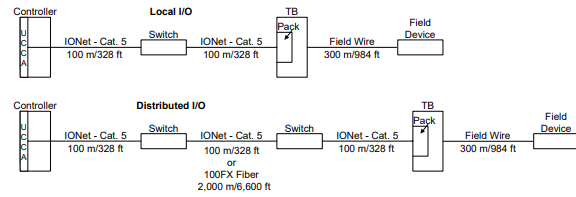
GE Energy Mark* VIe Control Product Description
12 C mechanical relays w/6 solenoids, coil diagnostics (115/230 V ac, 24/125 V dc) TRLYH1B 1 or 3
12 C mechanical relays w/6 solenoids, voltage diagnostics (115/230 V ac, 125 V dc) TRLYH1C 1 or 3
12 C mechanical relays w/6 solenoids, voltage diagnostics (24 V dc) TRLYH2C
6 A mechanical relays for solenoids, solenoid impedance diagn. (24/125 V dc) TRLYH1D 1 or 3
12 A solid-state relays/inputs (115/230 V ac) TRLYH1E 1 or 3
12 A solid-state relays/inputs (125 V dc) TRLYH2E 1 or 3
12 A solid-state relays/inputs (24 V dc) TRLYH3E 1 or 3
36 mechanical relays, 12 voted form A outputs TRLYH1F 3
12 fused branches WPDFH1A
36 mechanical relays, 12 voted form B outputs TRLYH2F 3
12 fused branches WPDFH2A
10 AI (V/I inputs) and (2AO (4-20/0-200 mA outputs) TBAIH1C 1 or 2 or 3
10 AI (V/I inputs) and (2AO (4-20/0-200 mA outputs) STAIH1A 1 or 2 or 3
16 AO (4-20 mA outputs) 8 per I/O pack TBAOH1C 1 or 2
8 AO (4-20 mA outputs) STAOH1A 1
12 thermocouples TBTCH1B 1 or 2 or 3
24 thermocouples (12 per I/O pack) TBTCH1C 1 or 2
12 thermocouples STTCH1A 1
16 RTDs 3 wires/RTD (8 per I/O pack) TRTDH1C 1 or 2
8 RTDs 3 wires/RTD SRTDH1A 1
6 serial ports for I/O drivers RS-232, RS422, RS485 SSCAH1A 1
10/2 analog I/O - HART communications SHRAH1A 1
PROFIBus communications SPIDH1A 1
I/O Type - Turbine Board
Redundant
Packs/Boards
Mixed I/O: 4 speed inputs/pack, synchronizing, shaft V/I monitor TTURH1C 1 or 3
2 servo channels: up to 3 coils, 4 LVDTs/channel, includes excitation TSVCH1A 1 or 3
8 vibration (seismic, proximity, accel.), 4 position, 1 reference probe, buffered out TVBAH1A 1 or 2 or 3
Controller

Features
• Single board including:
Main Processor
Control Network Communications - Ethernet
IO Network Communications – Ethernet
USB and COM ports
• Processor: Freescale 8349, 667MHz
• Operating system: QNX
• Base mounting
• Status LEDs
Environment
• Operating temperature 0°C to +65 °C
• No fans required
Features
• Single board including:
Main Processor
Control Network Communications - Ethernet
IO Network Communications – Ethernet
USB and COM ports
• Processor: Freescale 8349, 667MHz
• Operating system: QNX
• Base mounting
• Status LEDs
Environment
• Operating temperature 0°C to +65 °C
• No fans required
Mark VIe Controller
The single-board controller is a
compact and flexible design for
processing and network
communications.
The controller is a single board, which is base-mounted in the cabinet. For dual and
triple redundant systems, a second and third board can be mounted adjacent for a
compact packaging arrangement. An 8349, 667 MHz processor is provided with a
QNX operating system. The board is powered by 18-36 V dc, 12 watt source.
This rugged design is rated for an operating range of 0 to 65°C (32 to 149 °F) to
match the maximum operating temperature of the I/O modules. Also, it does not
require any cooling fans even at maximum temperature, and is suitable for NFPA
Class 1, Div. 2 applications.
Each controller has three 100 MB Ethernet drivers for the IONet, so that each
controller can communicate with up to three network switches. In redundant systems,
this allows each controller to monitor redundant inputs directly and compare them
for any potential discrepancies. Connectors are color-coded and labeled to simplify
maintenance.
Controllers also have two Ethernet drivers for the control network to communicate
peer-to-peer with other Mark VI, Mark VIe, and EX2100 generator excitation
controls, as well as operator and maintenance stations. Controllers can be
synchronized between units or to a local or remote time source for accurate plantwide sequence of events monitoring.
Switches manage the
communication traffic to
eliminate collisions and
increase network determinism
Communication between the controller and the I/O packs is performed with the
internal IONet. This is a 100 MB Ethernet network available in non-redundant, dual
redundant, and triple redundant configurations. Ethernet Global Data (EGD) and
other protocols are used for communication. EGD is based on the UDP/IP standard
(RFC 768). EGD packets are broadcast at the system frame rate from the controller
to the I/O packs, which respond with input data.
IONet conforms to the IEEE 802.3 standard. It is supplied as 100BaseTx and
100BaseFx (fiber) for greater distances, noise rejection, lightning immunity, and
ground immunity. A star topology is used with the controller on one end, a network
switch in the middle, and I/O packs at the end

Maximum IONet Distances Including Field Devices
Industrial grade switches are used for the IONet that meet the codes, standards,
performance, and environmental criteria for industrial applications including an
operating temperature of -40°C to 85°C (-40 °F to 185 °F) and Class 1, Div. 2.
Switches have provision for redundant 10 to 30 V dc power sources (200/400 mA)




























































































































